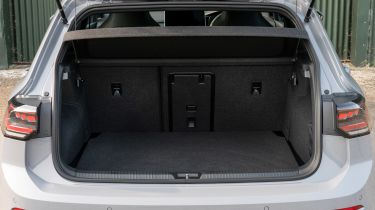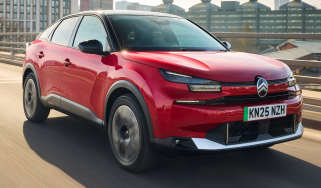Volkswagen Golf - Practicality, comfort and boot space
It’s a case of ‘as you were’ for the Mk8.5 Golf, with first-rate levels of comfort and just enough practicality

Previous generations of Volkswagen Golf have been available in both three- and five-door forms, but the latest Golf has gone down the more practical route of offering just a five-door body style only. The Volkswagen Golf Estate has been retained for those after a bit more versatility but don’t need something quite as big as a Volkswagen Passat. The pseudo-SUV Volkswagen Golf Alltrack with four-wheel drive has been dropped.
|
Dimensions | |
|---|---|
|
Length |
4,282mm |
|
Width |
1,789mm |
|
Height |
1,483mm |
|
Number of seats |
5 |
|
Boot space |
381-1,237 litres (273 litres eHybrid and GTE) |
Dimensions and size
The Mk8 Golf grew a few centimetres over the Mk7, and the update hasn’t changed this. The five-door hatchback is 4,284mm long, 1,789mm wide (excluding door mirrors), and 1,491mm in height.
How practical is the Volkswagen Golf?
Seats & space in the front
While many rivals have caught up when it comes to the VW Golf’s design and finish, the brand still really nails some other basics.
The driving position is spot on, while a wide amount of adjustment in both the front seat and the steering wheel makes it easy for most people to get comfortable behind the wheel. The large glass areas, plus the ability to raise the seat up high if necessary, mean that all-round visibility is better than in most rivals.
There are some well thought out storage areas, from the large glovebox to a dedicated smartphone slot complete with wireless charging. The latter is angled forward so your device can’t fall out of place while driving. The door bins are large and are carpeted both front and rear to stop items from rattling about. That does mean they’re not a great place to store snacks, though.
Seats & space in the back
Adults will find a reasonable amount of kneeroom compared with most rivals, while the flat roofline means that even taller people have space above their heads. The outer seats are quite sculpted, and are a little more upright than in other rivals.
Used - available now
If you need to squeeze three people in the back, the middle seat occupant will find the central position is fairly soft, and there’s a high central tunnel they’ll need to straddle, forcing their feet into the space of the other two occupants.
Storage is decent, with map pockets and smaller smartphone slots on the back of the front seats. If only two people are sitting in the rear, there’s a fold-down central armrest with a pair of cup-holders.
A pair of ISOFIX child seat mounting points are provided on the outer positions of the rear bench seat, plus the front passenger seat. The hooks in the back are hidden behind some easily removable plastic tabs.
Boot space
A 381-litre boot capacity isn’t the largest available in the segment, but it is a neatly designed shape with a fairly low loading lip. An adjustable height boot floor is also available, helping to create a level load area in its highest position when the rear seat backs are folded down. When in this configuration, the hatchback’s overall storage capacity increases to 1,237 litres.
Just be aware that the R model has a smaller 341-litre boot due to modifications needing to be made in order to accommodate the four-wheel drive system. The battery pack in the plug-in hybrid eHybrid and GTE models takes up even more space under the boot floor, reducing capacity to 273 litres.
Towing
If you're planning on using your Golf for towing duties then you'll be best served with the 148bhp 2.0-litre diesel that can tow a braked trailer or caravan of up to 1,600kg, or either the eHybrid and GTE plug-in hybrid models that can pull up to 1,700kg.
The 148bhp 1.5 TSI petrol and 114bhp 2.0 TDI diesel can haul around 1,500kg, while the 114bhp 1.5 TSI has 1,300kg of towing ability – although we suspect it’ll feel a bit underpowered up hills. Surprisingly, the Golf GTI and Golf R are both rated to tow, with max weights of 1,600kg and 1,700kg, respectively.














